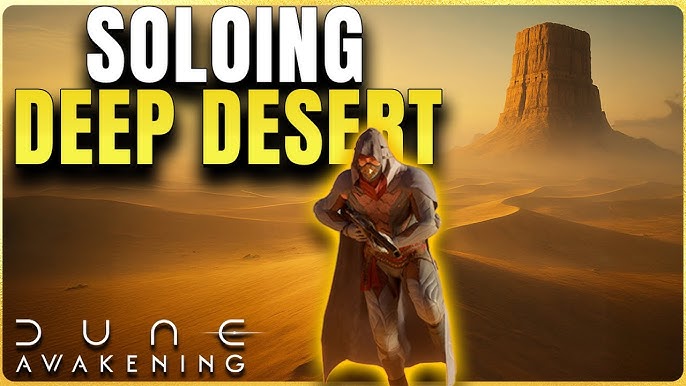- > Ultimate Guide to Choam Salvage Rights Event in Dune Awakening
- > Military Power Regulator in Dune Awakening - Complete Guide
- > How to Find Buried Treasure in Dune Awakening
- > Dune Awakening Wreck of Hephaestus Location & Quest Guide
- > 9 Secret Hagga Basin Loot Locations Only Veterans Know
- > Dune Awakening House Imota Location and Representative Guide
The Ultimate Dune Awakening Deep Desert Solo Guide
If you're planning to brave the Deep Desert solo in Dune Awakening, you're in for a wild ride. This is the game's endgame zone full of Tier 6 materials, fierce PvP, sandworms, shifting storms, and elite loot. Solo players can absolutely succeed—as long as you're prepared. For those looking to speed up your gear or stash before diving in, many solo veterans turn to DuneAwakeningItems.com to buy dune awakening solari and items safely and fast.
I've spent countless hours solo in the Deep Desert, scouting, base building, farming spice, mining Stravidium and Titanium, and surviving against sandworms and player raiders. Here's a veteran-to-veteran playbook on how to thrive solo in this harsh wasteland.
Understanding the Deep Desert Zones
The Deep Desert is split into a PvE-safe southern half and a fully PvP-enabled northern half. As of Patch 1.1, the map balances access so solo players can mine resources and explore without constant ganking—but the richest resources like Titanium and Stravidium Mass spawn mostly further north, in riskier PvP tiles.
You'll need to learn the geography of tiles (81 in a 9×9 grid), and plan travel across them carefully. Weekly Coriolis storms wipe all resources, bases, and structures—knowing the reset schedule gives you a strategic window to farm before raids hit.
Preparing Your Solo Toolkit
Gear and Build Setup
T4 gear is your bare minimum for solo viability: high-tier armor, radiation and cold resistance, and either shield or mobility upgrades. Use mobility modules like Vulture glide and Scout ornithopter abilities to avoid detection.
Vehicles
Scout ornithopter is the best solo transport. It's fast, stealthy, and ideal for entering foggy zones or dropping off sinks or spice runs. Save heavy rigs for team play—they attract worms and other players.
Inventory and Water
Bring a stilltent or portable purifier. Drinkable water's mandatory. Running out into the desert without hydration is mortal. Inventory capacity needs expansion mods or storage tents with base launches.
Blueprint Planning
Save multiple base blueprints. Deep Desert base wipes weekly, so you need fast rebuild layouts. Kit them with portable power cells, shields, and minimal walls you can erect quickly.
Solo PvE Actions To Prioritize
Sinkchart Scanning
Probe every tile at least once. Scanning yields intel, XP, and is one of the most repeatable low-risk solo loops. You can do all 81 tiles over time, staying in PvE zones.
Imperial Testing Stations and Eco-Labs
Solo dungeons in PvE tiles with reliable mid-tier loot. Clear carefully and pick up schematics or tiered materials—guided testing stations often hold unique schematics.
Spice Harvesting (with or without crawler)
PvE southern zones allow spice cultivations. Solo harvests use thumpers away from base to avoid sandworms. Gather small blooms or solo operate salvaged drills if you've earned access.
Titanium and Stravidium Mining
Requires Scout ornithopter and Cutteray Mk5 or better. Fly to rocky northern tiles, scan for high-tier nodes, and harvest carefully. You'll usually escape PvP by flying out quickly after mining.
Solo Base Tactics
Base Location Strategy
Staying near the edge of PvE/PvP boundary gives access to intel points and PvE safety. Build small resource bases in southern tiles near frequently scanned areas for easy resource retrieval.
Wipe Protection
Only build temporarily. Storm wipes everything weekly. Use saved base blueprints to redeploy immediately each cycle.
Shelter Against Worms
Digital shade helps. Turn off all power when away to avoid worm attraction. Avoid long travel in exposed zones without suspensors or natural rock cover.
Lone Explorer Challenges and How to Mitigate Them
PvP Exposure
Even near the boundary, players crossing into PvE tiles for ambush is possible. Use vehicle silence, avoid base operations openly, and always have an evasive route.
Resource Contest
Guilds and groups often dominate testing stations or outpost farming. Solo hunters may hit spots early or during low-pop hours for better loot.
Supply Logistics
Water, fuel, power cells—these are your lifelines. Day trading with tradeposts or tutorial vendors helps, but it's common to buy Solari or materials from trusted vendors like DuneAwakeningItems.com to keep momentum going.
Weekly Storm and Reset Strategy
The Coriolis storm resets everything every week. Solo players who understand the reset window can run resource sweeps on Monday before groups swarm. Once the storm hits, everything moves—bases, spice blows, testing stations, eco-labs relocate. Use that reposition to scout new weekly hotspots.
Intel and Outpost Participation
PvE and PvP outposts give Intel Points—30 from PvE, 40 from PvP. Intel is needed weekly to unlock faction tech, crafting tiers, and base upgrades. Solo players can access enough PvE outposts for steady tech unlock, but scaling tier craft often requires testing station schematics or PvP Intel runs.
Solo vs Guild Balance
Yes, guilds dominate spice and base raids. But solo players can excel in scanning, base raids reverse-nesting, resource mining, and intel farming. Many hardcore solos feed data back to their guilds or play as scout/support roles. There's no rule solo cannot compete—but your tools and discipline make the difference.
Final Words from a Veteran
Doing the Deep Desert solo isn't easy—it's brutal, relentless, and resource-intensive. But the sense of ownership is real. Nearly everything you achieve is earned solo: sinkcharts, gear, intel, and mastery over dynamic systems.
If you want to get ahead early and don't want to grind every Tier 6 site, consider getting your upgrades through DuneAwakeningItems.com to buy dune awakening items you need. That gives you freedom to focus on exploration and strategy, not component farming.
If you'd like help with gear mods, vehicle builds, scouting pads, or intel loops—just holler. Keep your wits sharp, wheels fired, and may Arrakis reward your perseverance.



